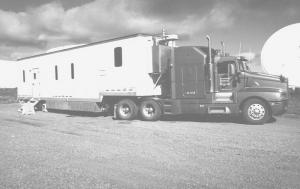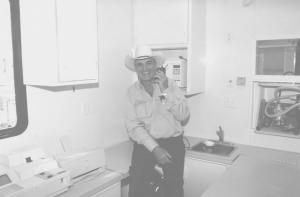Mobile Clinic Brings Vet Care To Remote Areas
To better serve the remote area his clients live in northern Alberta, veterinarian Dewey Stickney created what might be the world's first mobile full-service clinic. His 1994 Kenworth pulls a 50-ft. semi trailer equipped with a complete modern clinic.
The trailer has central heating, air conditioning, running water, on-board power, and separate rooms for surgery, examination, X-rays, and Stickney even included modest living quarters at the front of the unit. A satellite dish on the outside front of the van is tied into two televisions in the living area and waiting room, and a stereo system plays soothing music.
The mobile clinic serves a geographic area about 800 miles in length and 400 miles in breadth, with the majority of it being wilderness.
There are roughly 10,000 to 12,000 inhabitants centered mainly in five communities that I visit on a regular basis. There are no large population densities in these areas to justify a full-time clinic," he explains. "Residents of outlying areas usually come to the nearest center and clients with emergencies will usually come to one of our full-time clinics in Manning or Ft. Vermilion, or hunt me down if I'm closer."
The entire unit is 66 ft. long with a working weight of 44,000 lbs. and a fuel capacity of 200 gal. The drop-frame van is 13 ft. high and provides 400 sq. ft. of working space on the main floor. It also has under-slung basement compartments that house utilities such as wastewater storage, central air conditioning, water heaters, etc., and additional storage space. The drop-frame design of the van means it is lower profile, but it still has more clearance than a Greyhound bus, according to the vet. Efficient use of space above a dropped ceiling conceals utility lines and duct work.
I had to make the most of the room available, and still stay within legal highway requirements," he says. "A 200-gal. fresh water tank is recessed under the van's bed and there are sinks in both the exam and surgery rooms. I have a single compartment washer/dryer appliance in the lab/pharmacy and there is a bathroom in the front of the van. Each room has independent temperature controls and a power plant is attached to the front of the van."
Both the tractor-truck and the van have air-ride suspension that is deflated when the unit is parked. This results in a lower entry way and total stability when conducting clinics, Stickney explains.
Without dropping any numbers, Stickney admits the mobile rig was pricey, "but there was less investment than most people would think," he says, adding that, "it was cheaper than putting up a free-standing clinic."
I had the van conversion done at Northgate RV in Edmonton but I did all the design myself, saving engineering and architectural fees. It took about 10 months to finish and our maiden voyage with it was in July of 1999," he says. "It's a full-service companion animal clinic and makes a statement about the practice. It says to my clients that you can expect quality service and a sense of assurance."
Stickney uses the rig for 15 to 20 days each month, with two or three of those days spent traveling to the various communities he serves. The rates he charged his clients before building the rig have not changed. This is justified by the way the unit dramatically improved the efficiency of his practice, he says.
The Alberta vet continues to use a "booking agent" in each community to set up his appointment schedule on the road. His full-time mixed animal clinics in Ft. Vermilion and Manning operate while he is away, thanks to a partner, an associate, and a couple of animal health technicians.
One of the biggest impediments to providing veterinary service up here is finding enthusiastic veterinarians who are willing to reside here," Stickney says.
For more information, contact: FARM SHOW Followup, Dewey Stickney, Stickney Veterinary Service Ltd., Box 688, Manning, Alberta, Canada T0H 2M0 (ph 780 836-3770; fax 3848).

Click here to download page story appeared in.
Click here to read entire issue
Mobile Clinic Brings Vet Care To Remote Areas LIVESTOCK Handling 24-2-23 To better serve the remote area his clients live in northern Alberta, veterinarian Dewey Stickney created what might be the world's first mobile full-service clinic. His 1994 Kenworth pulls a 50-ft. semi trailer equipped with a complete modern clinic.
The trailer has central heating, air conditioning, running water, on-board power, and separate rooms for surgery, examination, X-rays, and Stickney even included modest living quarters at the front of the unit. A satellite dish on the outside front of the van is tied into two televisions in the living area and waiting room, and a stereo system plays soothing music.
The mobile clinic serves a geographic area about 800 miles in length and 400 miles in breadth, with the majority of it being wilderness.
There are roughly 10,000 to 12,000 inhabitants centered mainly in five communities that I visit on a regular basis. There are no large population densities in these areas to justify a full-time clinic," he explains. "Residents of outlying areas usually come to the nearest center and clients with emergencies will usually come to one of our full-time clinics in Manning or Ft. Vermilion, or hunt me down if I'm closer."
The entire unit is 66 ft. long with a working weight of 44,000 lbs. and a fuel capacity of 200 gal. The drop-frame van is 13 ft. high and provides 400 sq. ft. of working space on the main floor. It also has under-slung basement compartments that house utilities such as wastewater storage, central air conditioning, water heaters, etc., and additional storage space. The drop-frame design of the van means it is lower profile, but it still has more clearance than a Greyhound bus, according to the vet. Efficient use of space above a dropped ceiling conceals utility lines and duct work.
I had to make the most of the room available, and still stay within legal highway requirements," he says. "A 200-gal. fresh water tank is recessed under the van's bed and there are sinks in both the exam and surgery rooms. I have a single compartment washer/dryer appliance in the lab/pharmacy and there is a bathroom in the front of the van. Each room has independent temperature controls and a power plant is attached to the front of the van."
Both the tractor-truck and the van have air-ride suspension that is deflated when the unit is parked. This results in a lower entry way and total stability when conducting clinics, Stickney explains.
Without dropping any numbers, Stickney admits the mobile rig was pricey, "but there was less investment than most people would think," he says, adding that, "it was cheaper than putting up a free-standing clinic."
I had the van conversion done at Northgate RV in Edmonton but I did all the design myself, saving engineering and architectural fees. It took about 10 months to finish and our maiden voyage with it was in July of 1999," he says. "It's a full-service companion animal clinic and makes a statement about the practice. It says to my clients that you can expect quality service and a sense of assurance."
Stickney uses the rig for 15 to 20 days each month, with two or three of those days spent traveling to the various communities he serves. The rates he charged his clients before building the rig have not changed. This is justified by the way the unit dramatically improved the efficiency of his practice, he says.
The Alberta vet continues to use a "booking agent" in each community to set up his appointment schedule on the road. His full-time mixed animal clinics in Ft. Vermilion and Manning operate while he is away, thanks to a partner, an associate, and a couple of animal health technicians.
One of the biggest impediments to providing veterinary service up here is finding enthusiastic veterinarians who are willing to reside here," Stickney says.
For more information, contact: FARM SHOW Followup, Dewey Stickney, Stickney Veterinary Service Ltd., Box 688, Manning, Alberta, Canada T0H 2M0 (ph 780 836-3770; fax 3848).
To read the rest of this story, download this issue below or click
here to register with your account number.








